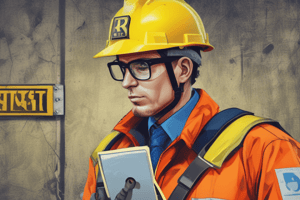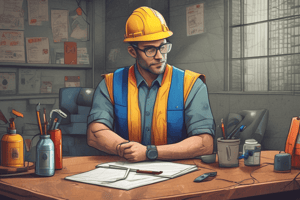Podcast
Questions and Answers
Which of the following is NOT a direct factor contributing to accidents in the workplace?
Which of the following is NOT a direct factor contributing to accidents in the workplace?
Which age demographic experiences the highest percentage of workplace accidents?
Which age demographic experiences the highest percentage of workplace accidents?
What is the most common reason for accidents occurring within the first three years of someone's job?
What is the most common reason for accidents occurring within the first three years of someone's job?
Which of the following is a potential hazard associated with equipment used in the workplace?
Which of the following is a potential hazard associated with equipment used in the workplace?
Signup and view all the answers
What is the primary factor that can contribute to heat exhaustion in the workplace?
What is the primary factor that can contribute to heat exhaustion in the workplace?
Signup and view all the answers
Which of the following is a potential consequence of insufficient illumination in the workplace?
Which of the following is a potential consequence of insufficient illumination in the workplace?
Signup and view all the answers
Which of the following scenarios can lead to a mechanical hazard?
Which of the following scenarios can lead to a mechanical hazard?
Signup and view all the answers
Which of the following is NOT a potential hazard associated with the physical environment?
Which of the following is NOT a potential hazard associated with the physical environment?
Signup and view all the answers
Which of the following is an example of an "Error of Omission"?
Which of the following is an example of an "Error of Omission"?
Signup and view all the answers
What is the primary goal of conducting an accident/incident investigation?
What is the primary goal of conducting an accident/incident investigation?
Signup and view all the answers
Which of the following is NOT considered a step in an accident/incident investigation?
Which of the following is NOT considered a step in an accident/incident investigation?
Signup and view all the answers
Why is it important to visit the accident scene before the physical evidence is disturbed?
Why is it important to visit the accident scene before the physical evidence is disturbed?
Signup and view all the answers
What is the most effective way to reduce human error in repetitive tasks?
What is the most effective way to reduce human error in repetitive tasks?
Signup and view all the answers
How can experienced clinical lab technicians negatively influence the behavior of inexperienced technicians?
How can experienced clinical lab technicians negatively influence the behavior of inexperienced technicians?
Signup and view all the answers
Why is it important to interview witnesses as soon as possible after an accident?
Why is it important to interview witnesses as soon as possible after an accident?
Signup and view all the answers
Flashcards
Social Environment
Social Environment
The context in which human behavior is influenced by others.
Human Errors
Human Errors
Unintended actions occurring during tasks, often categorized as mistakes or lapses.
Errors of Omission
Errors of Omission
A type of human error where a procedural step is not performed.
Examples of Omission
Examples of Omission
Signup and view all the flashcards
Errors of Commission
Errors of Commission
Signup and view all the flashcards
Examples of Commission
Examples of Commission
Signup and view all the flashcards
Accident Investigation
Accident Investigation
Signup and view all the flashcards
Steps of Investigation
Steps of Investigation
Signup and view all the flashcards
Direct factors of incidents
Direct factors of incidents
Signup and view all the flashcards
Personal characteristics
Personal characteristics
Signup and view all the flashcards
Job characteristics
Job characteristics
Signup and view all the flashcards
Equipment used
Equipment used
Signup and view all the flashcards
Physical environment
Physical environment
Signup and view all the flashcards
Electrical hazards
Electrical hazards
Signup and view all the flashcards
Mechanical hazards
Mechanical hazards
Signup and view all the flashcards
Radiation hazards
Radiation hazards
Signup and view all the flashcards
Study Notes
CLO4: Components of an Effective Health and Safety Management System
- This learning outcome is about recognizing the components of an effective health and safety management system.
Factors Contributing to Incidents/Accidents
- Human factors contribute significantly to incidents and accidents.
- Direct factors at the workplace need identification.
- Different types of human errors (omissions and commissions) should be distinguished.
- Accident/incident investigation components must be analyzed.
Why Accidents Happen
- Workplace accidents cause significant disability and death worldwide.
- The overall cost (financial, physical, and emotional) of workplace accidents is substantial.
- Accident rates have decreased since World War II due to improved working conditions.
- However, disabling injuries increased between 1961 and 1971.
Five Direct Factors Causing Accidents
- Personal characteristics (age, gender, experience, stress, fatigue, drugs, alcohol)
- Job characteristics (high physical/mental workload)
- Equipment used (controls/displays, electrical hazards, mechanical hazards, pressure/toxic substances)
- Physical environment (illumination, noise/vibration, temperature/humidity, fire hazards, radiation hazards, falls)
- Social environment (social context, behavior of others)
Human Factors Contributing to Accidents (Errors)
- Errors are unintended actions (mistakes, or lapses);
- They are common in repetitive tasks.
- Errors can be reduced by designing more user-friendly systems.
Two Types of Human Errors
-
Errors of Omission: Failure to perform a procedural step.
- Examples: forgetting to close a gas stove, forgetting to protect body parts during an X-ray.
-
Errors of Commission: Doing extra steps incorrectly or performing a step incorrectly.
- Examples: administering wrong medication, wrong dosage, to wrong patient, performing wrong surgical procedure.
Accident/Incident Investigation
- Accidents occur, and investigation is needed.
- Investigate to identify hazards that caused the accident or incident.
- Steps should be taken to prevent future injuries/illnesses.
- Common questions to ask during investigations include: WHEN did it happen? WHO was involved? WHERE did it happen? WHAT were they doing? WHY did it happen?
Steps of Accident/Incident Investigation
- Visit accident scene before evidence is affected.
- Make visual records (Sketches, Photos, Notes, conditions of area)
- Preserve accident related items.
- Identify people who can help determine cause(s).
- Interview witnesses promptly.
- Document/review accident information.
Studying That Suits You
Use AI to generate personalized quizzes and flashcards to suit your learning preferences.
Description
This quiz covers the essential components of an effective health and safety management system. You will learn about the factors contributing to workplace incidents and why accidents happen, along with an analysis of accident investigation components. Test your knowledge on safety protocols and human factors impacting workplace safety.




